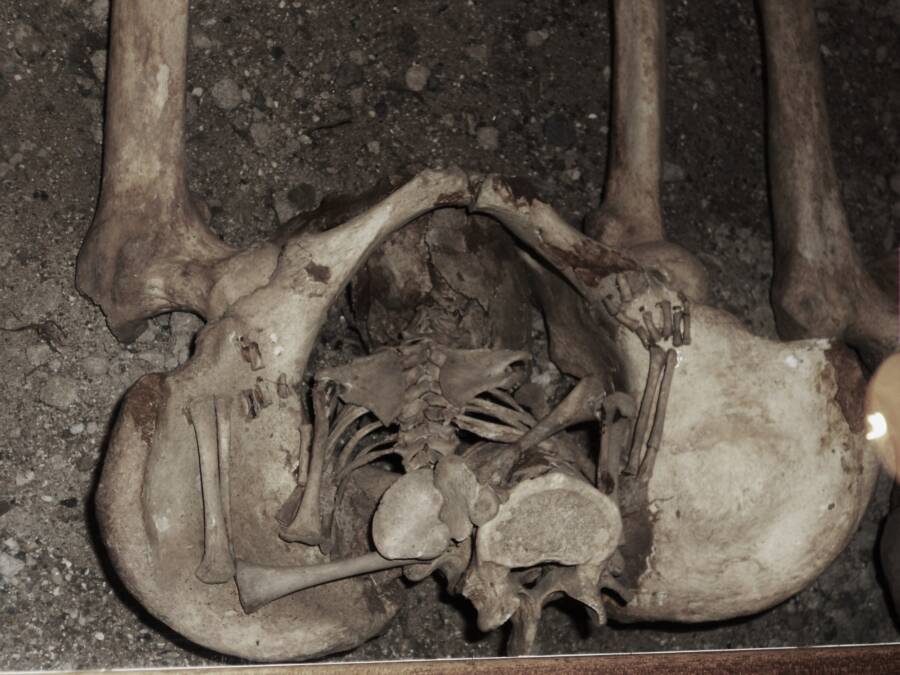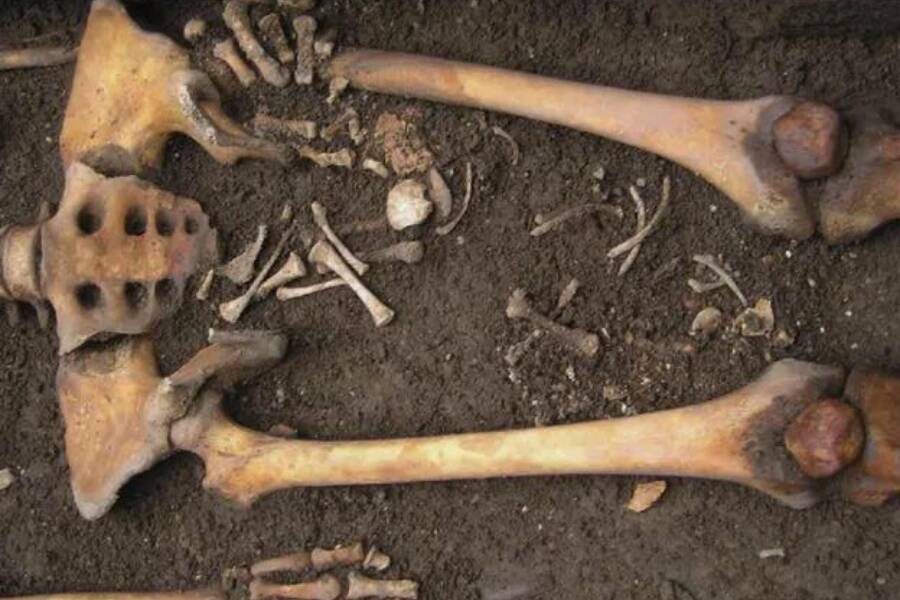A rare phenomenon, a coffin birth occurs after abdominal gases build up in a pregnant corpse, ejecting the fetus from the woman's body.
In one of the rarest postmortem phenomena in history, a small number of deceased pregnant women have “given birth” to an unviable fetus after dying. Known as a coffin birth or postmortem fetal extrusion, this phenomenon is just as grisly and horrifying as the name would suggest.
This happens due to a gas buildup in the pregnant corpse’s body. That, combined with the natural decomposition and swelling of the woman’s corpse, causes the body to expel the unborn child.
Oftentimes in these cases, the fetus is already dead by the time of the woman’s burial.

Caitlin Doughty/YouTubeRemains of a coffin birth, with a fetal skeleton inside of an adult’s skeleton.
Fortunately, modern embalming practices have mostly stopped coffin births from happening, making them even rarer now than they were centuries ago. Still, this phenomenon is not totally impossible today.
Recorded Cases Of Coffin Births From History
One of the earliest recorded cases of a coffin birth happened when the Spanish Inquisition was in full swing. This institution was set up by the Spanish Crown to punish people for heresy in Spain from 1478 to 1834. Jews, Muslims, and anyone else who wasn’t Catholic were in danger of being subjected to forced conversion, torture, and even execution.
In one particularly gruesome case, a pregnant woman was hanged in 1551 after being tried by the Spanish Inquisition. Her corpse was left hanging for about four hours — and then, suddenly, two dead infants fell from her body. Little else is known about this morbid story or why the coffin birth happened so soon after the execution, but it’s possible the conditions around her body caused the corpse to putrefy at an accelerated rate.
Then, in 1650, an English woman named Emme Toplace allegedly gave birth to a live baby boy just hours after her burial. Records state that the child was successfully rescued after multiple witnesses reported hearing “rumbling” and “sighing” coming from Emme’s grave, along with the “crying of a child.” The boy reportedly lived and was named Fils de la terre, meaning Son of the Earth. If this story is true, it’s possible that Emme had accidentally been buried alive and was taking her final breaths while giving birth.

Vladimir BazaliiskiiA prehistoric grave unearthed in Siberia, where a coffin birth occurred.
The 1896 medical compendium Anomalies and Curiosities of Medicine cites several other examples of coffin births. Interestingly enough, some of these allegedly occurred before the woman’s actual burial, but in many cases throughout history, a coffin birth is discovered long after the woman dies.
For example, in 2010, archaeologists in Imola, Italy discovered the medieval grave of a pregnant woman who had died during the 7th or 8th century. They also uncovered the remains of her fetus, which lay between her legs. It was later revealed that the fetus, which was already dead at the time of the mother’s burial, was partially ejected from the birth canal in the grave.
Even centuries ago, coffin births were extremely rare. Experts say it’s been observed “infrequently” in the archaeological record, and written accounts of postmortem fetal extrusions are also scarce. Still, countless medical authorities have been studying these cases for centuries.
What Really Causes A Coffin Birth?
Though experts understand the basic facts behind a coffin birth, there are still some things they don’t know — especially since it happens so rarely.
When the phenomenon does happen, it usually occurs between 48 and 72 hours after the death of the pregnant woman. As the body naturally decomposes and swells after death, abdominal gases build up, and can occasionally push on the uterus so intensely that the fetus is pushed through the vaginal opening. But while this may seem like a “birth” after the mother’s death, the fetus is also typically dead at this point.
But why does the pressure get so intense that the fetus is pushed out? What conditions make this phenomenon more likely to happen? And what are we to make of centuries-old records of “live” coffin births?
Part of the issue with determining how and why these things happen is, of course, that no one has actually been able to scientifically observe the process in action, for reasons that should not need to be explained.

University of FerraraA coffin birth found in a medieval grave in Italy, uncovered in 2010.
One likely explanation for why this occurs has to do with how the body breaks down and putrefies after death. As this happens, bacteria in the gut begin to increase and spread rapidly. Per the National Library of Medicine, this in turn increases the amount of gases that are present in the body, including carbon dioxide, methane, and hydrogen sulfide.
These gases cause the corpse to become bloated, and as the body’s tissues weaken, fluids are pushed out of the orifices. Those gases can also potentially push down on the uterus, expelling the fetus from the body.
While coffin births have always been highly unusual, they are especially rare in the modern world due to present-day embalming practices and the rising popularity of funerary methods like cremation. With greater medical knowledge, and greater expert interference after death, coffin births are extremely unlikely to occur after the deaths of pregnant women today.
They do, however, still happen in today’s world.
Modern Examples Of Coffin Births
In 2005, a 34-year-old woman was found dead in her home in Germany from an apparent overdose of heroin. She was also eight months pregnant at the time of her death, and her dead fetus was found partially emerged from the birth canal — presumably a modern case of a coffin birth.
Three years later, in 2008, another modern-day coffin birth was uncovered after a 38-year-old woman in Panama disappeared from her home. Four days later, she was found brutally murdered. She had been seven months pregnant at the time of her death, and it was soon discovered that her dead body had expelled her dead fetus at some point after her murder.
Surprisingly, in that case, the fetus was still attached to the placenta, which had apparently not been ejected from the body.
And even more recently, when the body of pregnant Shanann Watts was discovered in a shallow grave in 2018 — after she and her two children were murdered by her husband Chris Watts — her autopsy revealed that her body expelled her 15-week-old fetus, which would’ve been a boy named Nico.
These are, of course, incredibly rare and tragic examples of this strange phenomenon, but it goes to illustrate the point that postmortem fetal extrusions do still happen, sadly. As morbid as coffin births are, they are a distilled representation of the thin line between life and death.
Now that you’ve read about coffin births, discover terrifying true stories of people being buried alive. Then, learn about Lenin’s Mausoleum and how he became the best-preserved corpse on Earth.





